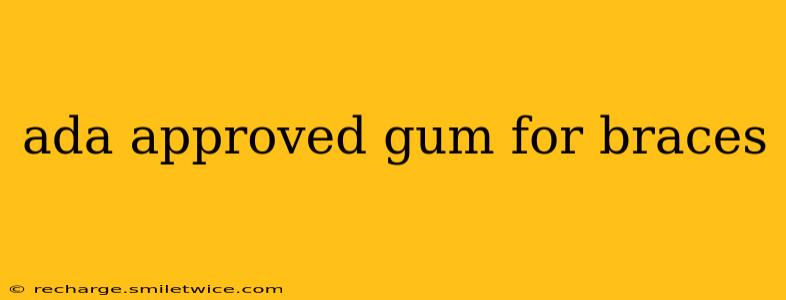Having braces can be a challenge, impacting your daily routine and even your diet. One common question many orthodontists hear is, "What kind of gum can I chew with braces?" While chewing gum isn't generally recommended during orthodontic treatment due to the risk of damaging brackets or wires, understanding the nuances of gum selection and its potential impact is crucial. This guide explores ADA-approved chewing gum options and considerations for brace wearers. It's important to note that this information is for general knowledge and should not replace advice from your orthodontist. Always consult your orthodontist before making any changes to your oral hygiene routine, especially when wearing braces.
What Does ADA Approved Mean?
The American Dental Association (ADA) Seal of Acceptance is a voluntary program that signifies a product has met the ADA's standards for safety and effectiveness. For chewing gum, this typically means it's been evaluated for its impact on dental health, including cavity prevention and gum health. An ADA seal doesn't guarantee the gum is suitable for braces, however.
Is Any Gum Safe for Braces?
The short answer is no. While some gums might be ADA-approved, most types are not recommended for brace wearers. The risk of damaging your braces by sticking gum to brackets or exerting excessive pressure while chewing is significant. The sticky nature of most gums can also trap food particles, leading to plaque buildup and potential gum irritation.
What Types of Gum Should You Avoid With Braces?
Avoid all types of chewing gum that are:
- Sticky: The stickiness of many gums increases the likelihood of gum getting trapped and damaging your braces.
- Hard: Hard candies or very firm gums can put excessive pressure on brackets and wires, potentially causing them to break or shift.
- Sugar-laden: High sugar content promotes tooth decay, a particular concern for brace wearers who may have difficulty cleaning around their brackets effectively.
What Can I Chew on Instead of Gum?
Many people chew gum to alleviate stress or satisfy a craving. If you find yourself missing the act of chewing, here are some safer alternatives:
- Sugar-free hard candies: While still carrying a risk of breakage, these might be less sticky than gum. Always consult your orthodontist before trying these.
- Sugar-free lollipops: Similar to hard candies, but potentially less risky depending on their hardness. Always consult your orthodontist before trying these.
Can I Chew Sugar-Free Gum With Braces?
While some sugar-free gums are ADA-approved, it is generally still not recommended to chew any gum while wearing braces. The risk of damage, even with sugar-free options, outweighs the benefits.
What if I Accidentally Get Gum Stuck in My Braces?
If you accidentally get gum stuck, do not try to force it out. This could damage your braces. Instead, gently rinse your mouth with water and try to dislodge the gum with a soft toothbrush. If you can't remove it, contact your orthodontist immediately.
How Can I Maintain Good Oral Hygiene With Braces?
Maintaining excellent oral hygiene is crucial with braces. This includes:
- Brushing: Brush thoroughly after every meal, paying close attention to the areas around your brackets and wires. An electric toothbrush can be particularly helpful.
- Flossing: Use a floss threader to carefully clean between your teeth and under your wires.
- Using a Waterpik: A water flosser can help remove food particles and plaque in hard-to-reach areas.
- Regular Dental Checkups: Maintain regular visits to your dentist and orthodontist for checkups and professional cleanings.
Remember, your orthodontist is your best source of information regarding safe practices while wearing braces. Always consult them before making any decisions regarding your diet or oral hygiene routine. The information above is for general knowledge and should not be considered medical advice.
